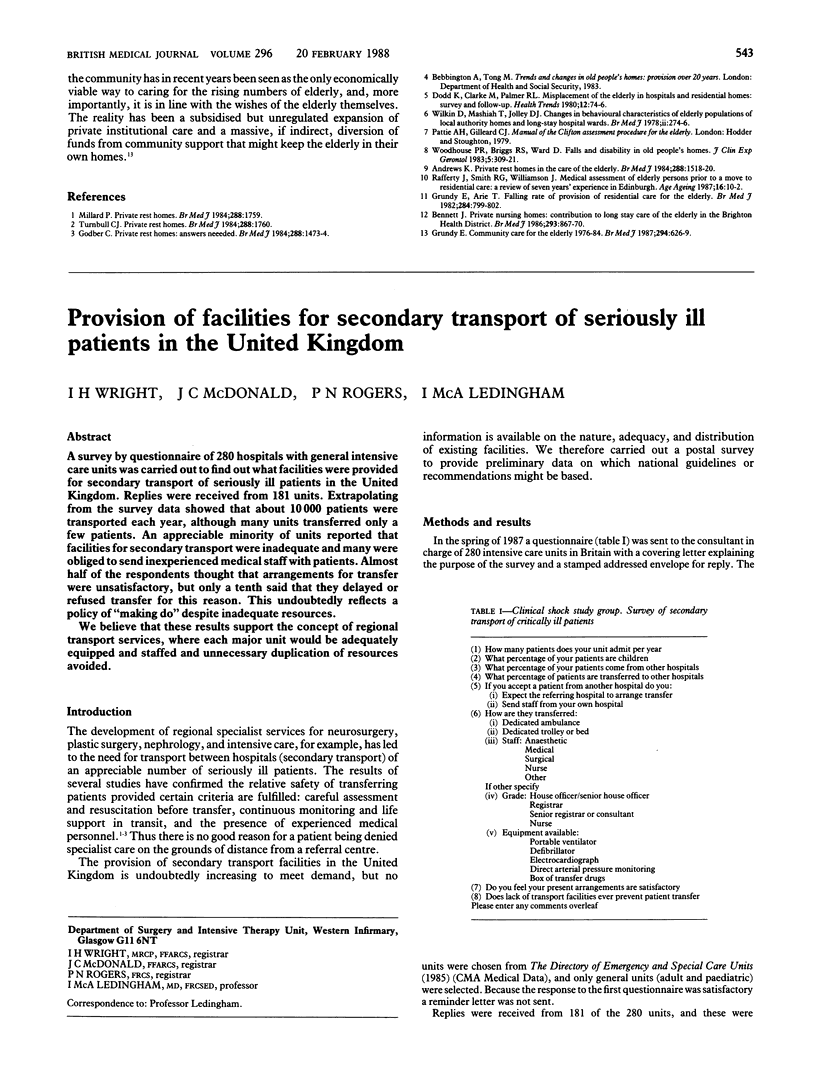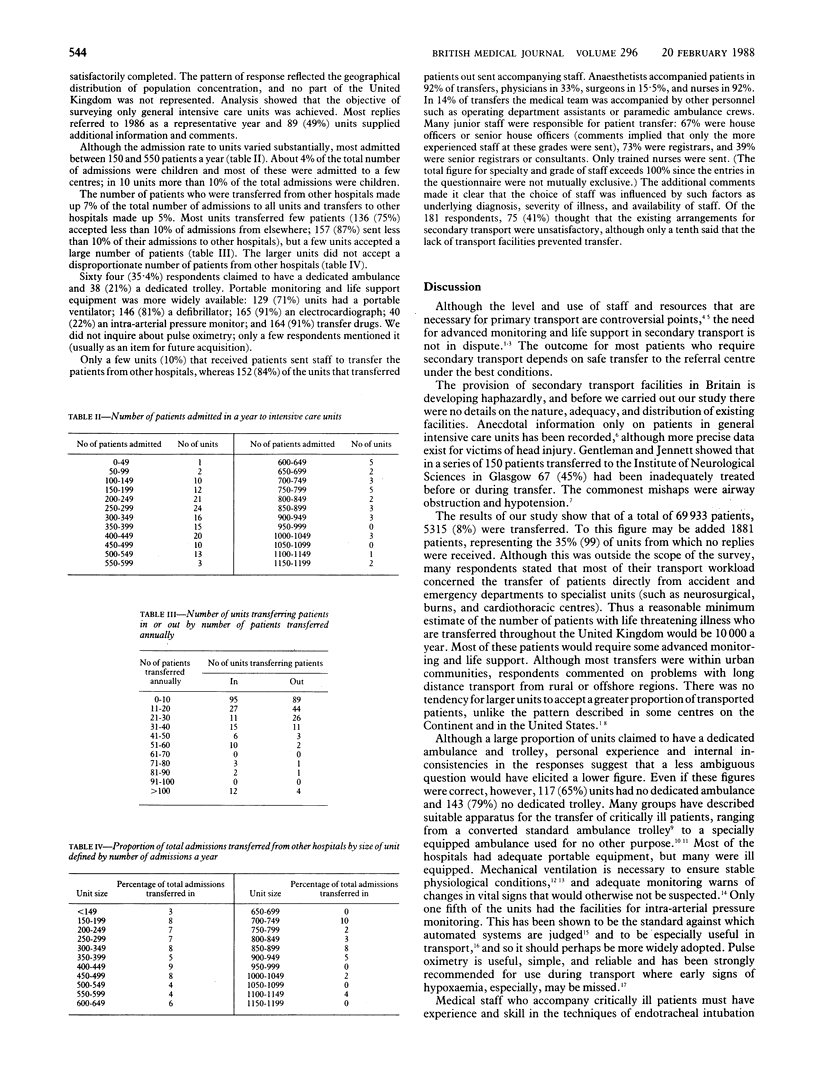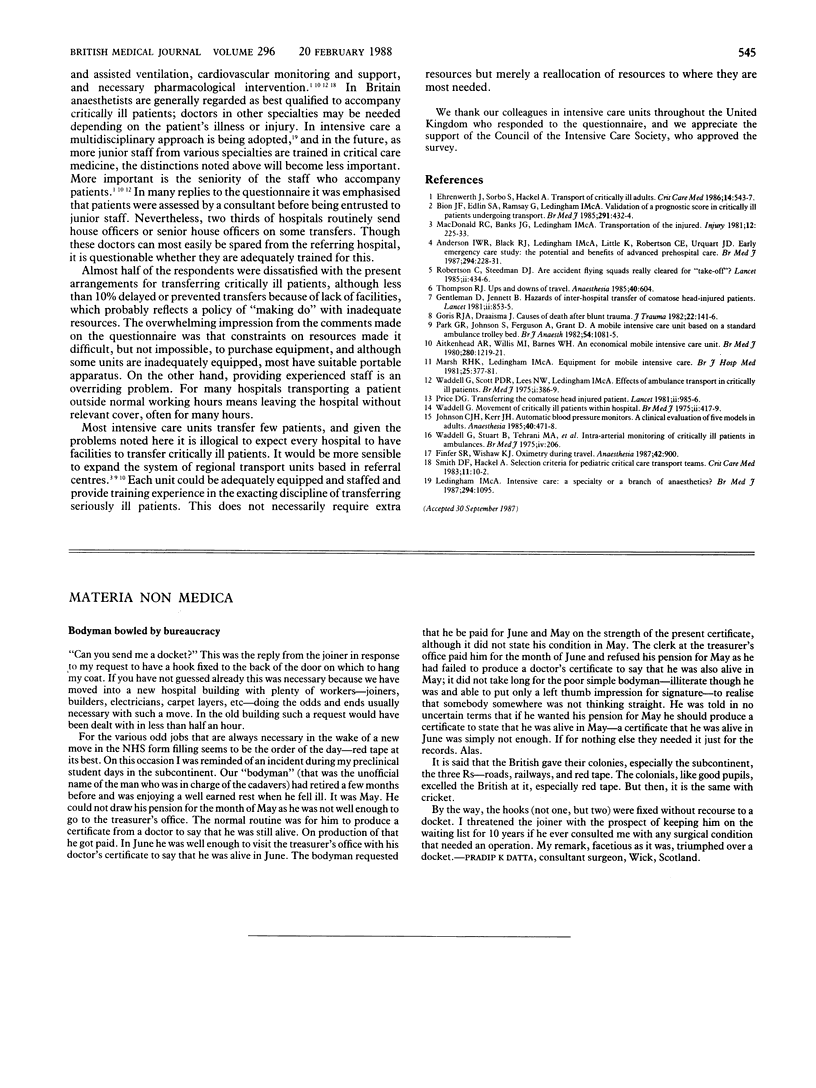Abstract
A survey by questionnaire of 280 hospitals with general intensive care units was carried out to find out what facilities were provided for secondary transport of seriously ill patients in the United Kingdom. Replies were received from 181 units. Extrapolating from the survey data showed that about 10 000 patients were transported each year, although many units transferred only a few patients. An appreciable minority of units reported that facilities for secondary transport were inadequate and many were obliged to send inexperienced medical staff with patients. Almost half of the respondents thought that arrangements for transfer were unsatisfactory, but only a tenth said that they delayed or refused transfer for this reason. This undoubtedly reflects a policy of “making do” despite inadequate resources.
We believe that these results support the concept of regional transport services, where each major unit would be adequately equipped and staffed and unnecessary duplication of resources avoided.
Full text
PDF


Selected References
These references are in PubMed. This may not be the complete list of references from this article.
- Aitkenhead A. R., Willis M. I., Barnes W. H. An economical mobile intensive care unit. Br Med J. 1980 May 17;280(6225):1219–1221. doi: 10.1136/bmj.280.6225.1219. [DOI] [PMC free article] [PubMed] [Google Scholar]
- Anderson I. W., Black R. J., Ledingham I. M., Little K., Robertson C. E., Urquhart J. D. Early emergency care study: the potential and benefits of advanced prehospital care. Br Med J (Clin Res Ed) 1987 Jan 24;294(6566):228–231. doi: 10.1136/bmj.294.6566.228. [DOI] [PMC free article] [PubMed] [Google Scholar]
- Bion J. F., Edlin S. A., Ramsay G., McCabe S., Ledingham I. M. Validation of a prognostic score in critically ill patients undergoing transport. Br Med J (Clin Res Ed) 1985 Aug 17;291(6493):432–434. doi: 10.1136/bmj.291.6493.432. [DOI] [PMC free article] [PubMed] [Google Scholar]
- Ehrenwerth J., Sorbo S., Hackel A. Transport of critically ill adults. Crit Care Med. 1986 Jun;14(6):543–547. doi: 10.1097/00003246-198606000-00005. [DOI] [PubMed] [Google Scholar]
- Gentleman D., Jennett B. Hazards of inter-hospital transfer of comatose head-injured patients. Lancet. 1981 Oct 17;2(8251):853–854. doi: 10.1016/s0140-6736(81)91115-6. [DOI] [PubMed] [Google Scholar]
- Goris R. J., Draaisma J. Causes of death after blunt trauma. J Trauma. 1982 Feb;22(2):141–146. doi: 10.1097/00005373-198202000-00011. [DOI] [PubMed] [Google Scholar]
- Johnson C. J., Kerr J. H. Automatic blood pressure monitors. A clinical evaluation of five models in adults. Anaesthesia. 1985 May;40(5):471–478. doi: 10.1111/j.1365-2044.1985.tb10851.x. [DOI] [PubMed] [Google Scholar]
- Kinsella S. M. Needlestick injury from indwelling steel needle. Anaesthesia. 1987 Aug;42(8):900–901. doi: 10.1111/j.1365-2044.1987.tb04134.x. [DOI] [PubMed] [Google Scholar]
- Ledingham I. M. Intensive care: a specialty or a branch of anaesthetics? Br Med J (Clin Res Ed) 1987 Apr 25;294(6579):1095–1095. doi: 10.1136/bmj.294.6579.1095. [DOI] [PMC free article] [PubMed] [Google Scholar]
- Marsh R. H., Ledingham I. M. Equipment for mobile intensive care. Br J Hosp Med. 1981 Apr;25(4):377-8, 381-2, 384-5. [PubMed] [Google Scholar]
- Park G. R., Johnson S., Ferguson A., Grant D. A mobile intensive care unit based on a standard ambulance trolley bed. Br J Anaesth. 1982 Oct;54(10):1081–1085. doi: 10.1093/bja/54.10.1081. [DOI] [PubMed] [Google Scholar]
- Price D. G. Transferring the comatose head-injured patient. Lancet. 1981 Oct 31;2(8253):985–986. doi: 10.1016/s0140-6736(81)91179-x. [DOI] [PubMed] [Google Scholar]
- Robertson C., Steedman D. J. Are accident flying squads really cleared for "take-off"? Lancet. 1985 Aug 24;2(8452):434–436. doi: 10.1016/s0140-6736(85)92749-7. [DOI] [PubMed] [Google Scholar]
- Smith D. F., Hackel A. Selection criteria for pediatric critical care transport teams. Crit Care Med. 1983 Jan;11(1):10–12. doi: 10.1097/00003246-198301000-00004. [DOI] [PubMed] [Google Scholar]
- Waddell G., Scott P. D., Lees N. W., Ledingham I. M. Effects of ambulance transport in critically ill patients. Br Med J. 1975 Feb 15;1(5954):386–389. doi: 10.1136/bmj.1.5954.386. [DOI] [PMC free article] [PubMed] [Google Scholar]
- Waddell G., Stuart B., Tehrani M. A., McGarrity G., Reyes A., Smith H. C., Ledingham I. M., Green H. L., Weller C. Intra-arterial monitoring of critically ill patients in ambulances. Br Med J. 1975 Oct 25;4(5990):206–206. doi: 10.1136/bmj.4.5990.206. [DOI] [PMC free article] [PubMed] [Google Scholar]


